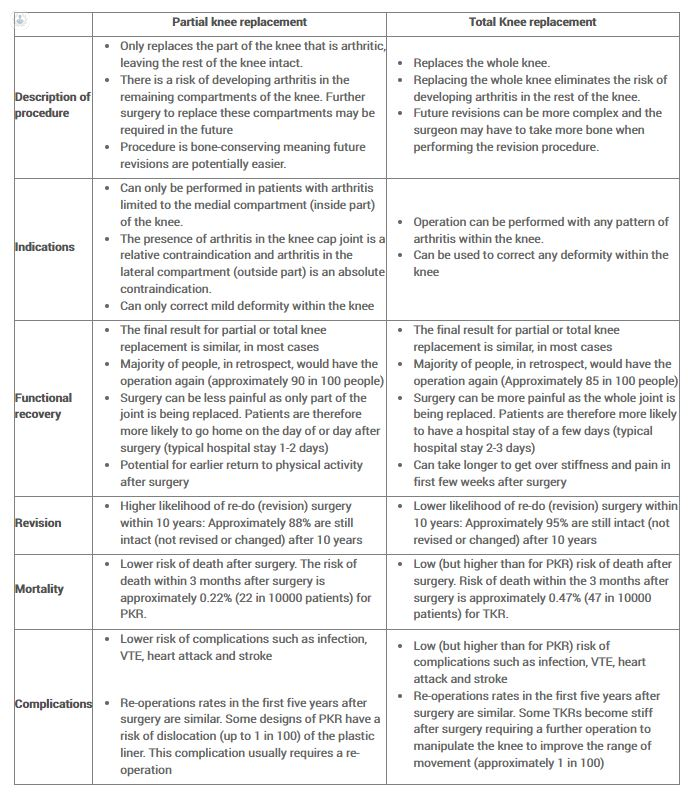Total vs. partial knee replacement: what's the difference?
Autore:Total and partial knee replacements are surgical options for individuals suffering from degeneration of the knee. Although they may seem very similar, several differences between the two should be explored. Leading Darlington-based consultant orthopaedic surgeon Mr Andrew Port shares his expertise on both surgeries. Before undergoing either a TKR or a PKR, potential patients should understand how each surgery is performed, the recovery periods associated with them, the expected side effects, and complications from both. Following an informed discussion and individual assessment with your surgeon, you should have a good understanding as to which choice is the most suitable option for your particular circumstances. In addition, those who have undergone either procedure should know the chances of needing revision surgery associated with both a TKR and a PKR

How do I know if I need a total (TKR) or partial (PKR) knee replacement?
A partial knee replacement (PKR) can only be performed on patients with arthritis limited to the medial compartment, the inside part, of the knee. In some cases of arthritis in the knee cap joint, the benefits of a PKR may outweigh the risks and be favoured, however, it is not suitable to treat arthritis in the lateral compartment (outside part). Total knee replacement (TKR) can be performed with any type of arthritis within the knee.
Additionally, a PKR can only correct mild deformities within the knee, yet a TKR can be used to correct any deformity.
What is the difference between a partial (PKR) and a total (TKR) knee replacement?
A PKR only replaces the part of the knee that is arthritic, leaving the rest of the knee intact, whilst a TKR replaces the whole knee. Replacing the whole knee eliminates the risk of developing arthritis in the rest of the knee. If only the arthritic part of the knee is replaced, there is a risk of developing arthritis in the remaining parts of the knee. Further surgery to replace these compartments may be required in the future. PKR is bone-conserving, meaning future revisions are potentially easier, but revisions for TKR can be more complex, resulting in the surgeon needing to remove more bone when performing it.


What can I expect after a partial or total knee replacement?
The final result for partial or total knee replacement is similar, in most cases. The majority of people will not need to have the operation again; 90% of PKR and 95% of TKR will last more than 10 years.
Partial replacement surgery is generally less painful as only part of the joint is being replaced and patients are likely to go home on the day of or the day after surgery. The recovery is generally easier and as the operation involves less surgery, the result is more often a more natural feel to the knee and generally a quicker return to full function in the order of 3-6 months.
On the other hand, recovery from a TKR can take a bit longer as there is more stiffness and pain in the first few weeks after surgery since the whole joint is being replaced. Patients typically have a longer recovery and can take up to a year to settle.
What is the likelihood of needing revision surgery after a partial or total knee replacement?
There is a slightly higher likelihood of needing revision surgery within 10 years for a PKR than for a TKR. Approximately 90% of partial replacements are intact and don’t need to be revised or changed after ten years, but in the case of total replacements, it is about 95%.
What is the mortality rate from a partial or total knee replacement?
Although the risk of death from both procedures is extremely low, there is a slightly higher risk following a TKR than a PKR. Following a PKR, the risk of death within 3 months after surgery is approximately 0.22% (22 in 10000 patients), while after a TKR the risk is approximately 0.47% (47 in 10000 patients) 3 months post-surgery.
What complications can occur after a partial or total knee replacement?
There is a low risk of complications, such as infection, venous thromboembolism (VTE), heart attack, or stroke following a knee replacement surgery. The risk is slightly higher in patients who undergo a TKR rather than a PKR.
If you are interested in booking a consultation with Mr Andrew Port to discuss your options for a knee replacement, you can book one directly vis his Top Doctors profile.



